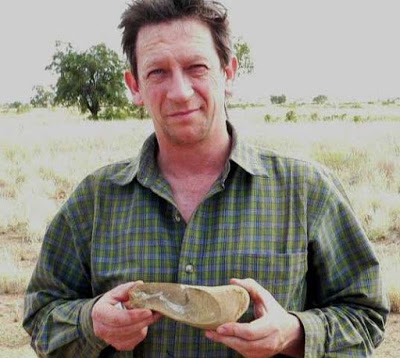
Most people know that sharks have a distinctive, all-cartilage skeleton, but now a fossil from Western Australia has revealed a surprise ‘missing link’ to an earlier, more bony form of the fish.
Published today in the scientific journal PLOS One, research by Flinders University palaeontologist Professor John Long substantially strengthens the theory that the modern shark is less primitive than previously believed.
In testing fossil remains discovered by Professor Long in July 2005 at Gogo in the Kimberley in Western Australia, detailed CT scanning analysis has shown that the three-dimensional remnant skeleton contains a small proportion of bone as well as cartilage.
Professor Long said the fossil, which dates from the Devonian Period (380 million years old), reveals an ancient shark caught in evolutionary transition.
Because sharks and rays have entirely cartilaginous skeletons, Professor Long said it was traditionally thought that they were part of a primitive evolutionary pathway, and that bone in other fish was the more advanced condition.
But a series of discoveries in recent years has suggested that sharks are “more evolutionarily derived”, and are likely to be descended from bony ancestors.
“Our shark more or less nails that theory, because here we have a heavily mineralised type of cartilage in the skeleton, which contains remnant bone cells,” Professor Long said.
“It’s almost a missing link condition showing that early sharks had a lot more bone in their skeleton, and that just before modern sharks evolved they lost the bone, with only the soft cartilage remaining.”
Professor Long said the research indicates a direction in their evolution that shows that sharks to be much more specialised than previously thought.
The Gogo formation, which is the remains of a tropical reef now located far inland, has proved to be one of the most important sources of Devonian fossil fish in the world.
Professor Long said sharks are poorly known from the Devonian period, with research heavily reliant on fossil teeth. The rarity makes the Gogo shark all the more remarkable, Professor Long said.
“This is a partial articulated skeleton, with the jaws and shoulder and all the teeth and scales, but best of all, we have acid-etched the fossils out of the rock, so they are three-dimensional, uncrushed and perfect,” he said. “It’s the first time a shark of that age has been prepared in that manner.”
“This is a really interesting discovery,” said Professor Per Ahlberg, a palaeontologist at Uppsala University in Sweden, which was not involved in the study.
“The new Gogo shark shows what seems to be an early version of prismatic calcified cartilage: unlike the modern kind, the gaps between the prisms contain cells that resemble bone cells. This may help to explain the relationship between prismatic calcified cartilage and bone.”
The find also represented a breakthrough in that it was the first specimen of a shark discovered at the Gogo site in 60 years of investigation.
“It means that we can go back and find more sharks with continued collecting,” said Professor Long, who will head back to the site later this year.
Reference:
“First Shark from the Late Devonian (Frasnian) Gogo Formation, Western Australia Sheds New Light on the Development of Tessellated Calcified Cartilage.” PLoS ONE 10(5): e0126066. DOI: 10.1371/journal.pone.0126066
Note : The above story is based on materials provided by Flinders University.










